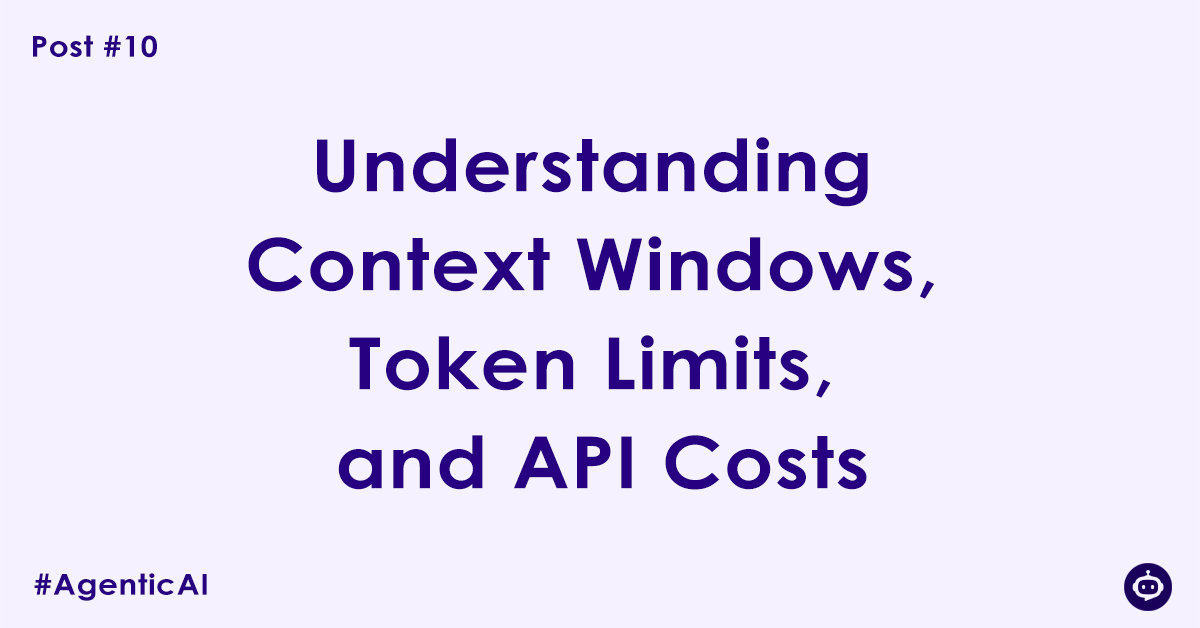In our journey so far, we’ve explored the incredible capabilities of AI agents—designing their personalities, crafting advanced prompts, and making them “think” methodically. We’ve been designing a high-performance race car. Now, it’s time to talk about the realities of driving it: the size of the fuel tank, the rate of fuel consumption, and, most importantly, the price of the fuel itself.
While the potential of agents can feel limitless, they operate within a firm set of technical and financial constraints. Understanding these practicalities is essential for moving from a cool prototype to an efficient, scalable, and sustainable application.
1. The Context Window: The Agent’s Short-Term Memory
The context window is the maximum number of tokens (pieces of words) that a model can “see” and process at any given time. This includes everything: the system prompt, any few-shot examples, the user’s entire conversation history, and the newly generated response.
Analogy: Think of the context window as the model’s whiteboard. It can only reason about the information currently written on the board. Any information from a previous conversation that got “erased” to make room for new text is effectively forgotten.
Why it Matters:
- Conversation Limits: This is why a chatbot can “forget” details from the beginning of a very long conversation. As new messages are added, the oldest ones fall out of the context window.
- Document Analysis: It limits the size of a document you can reason about in a single pass. You can’t just paste a 300-page report into an agent with an 8,000-token context window and expect it to understand the whole thing at once.
- Prompt Overhead: Your carefully crafted system prompt, persona, and few-shot examples all consume space on the whiteboard, leaving less room for the user’s actual query and the model’s response.
Real-World Scale: Context windows have been expanding rapidly. A few years ago, 2,000-4,000 tokens was standard. Now, models commonly offer 32,000, 128,000, and even up to 1-2 million tokens (like Google’s Gemini 1.5 Pro). For reference, 8,000 tokens is roughly 10-12 pages of a standard book. A larger window allows for much longer memories and more complex, single-pass analysis.
2. Token Limits: The Hard Cap on Output
Closely related to the context window is the output token limit. This is the maximum number of tokens the model is allowed to generate in a single response.
Analogy: If the context window is the size of your whiteboard, the output token limit is the amount of ink you’re allowed to use for your answer.
Why it Matters:
- Truncated Responses: If you ask an agent to perform a task that requires a very long output, like “write a detailed 10-page report,” it might stop abruptly mid-sentence when it hits its generation limit.
- Agent Design: This forces developers to design agents that are either concise or can break down large tasks into smaller, sequential steps. You can’t ask the agent to “write a novel” in one command.
- API Errors: The total tokens (input from your prompt + output from the model) cannot exceed the model’s absolute maximum limit. Pushing against this will result in a failed request.
3. API Costs: Paying for Every Thought
Using a state-of-the-art LLM from providers like Google, OpenAI, or Anthropic is a metered service, and the currency is tokens. This is perhaps the most critical real-world constraint.
Analogy: Using an LLM API is like using electricity. Every appliance (model) has a consumption rate, and the meter is always running. You pay for exactly what you use.
How the Cost Model Works:
- Pay-per-Token: You are billed for the total number of tokens you process, both in your prompt (input) and in the model’s response (output).
- Input vs. Output Pricing: Crucially, output tokens are almost always more expensive than input tokens. The model has to do more computational “work” to generate a response than it does to read your prompt.
- Model Tiers: The most powerful, cutting-edge models (like GPT-4 Turbo or Claude 3 Opus) cost significantly more per token than their faster, smaller counterparts (like GPT-3.5 Turbo or Gemini Flash).
Why it Matters for Agent Design:
- Prompt Efficiency is Cost Efficiency: Every token in your system prompt, every example in your few-shot prompt, is a recurring cost on every single API call. Long, inefficient prompts can bankrupt a project at scale.
- Verbosity is Expensive: A “chatty” agent that provides long, narrative answers will be far more costly than one that provides concise, direct responses.
- Scalability: A prototype that costs $0.01 per user interaction might seem cheap. But when you scale to 100,000 interactions a day, that becomes $1,000 daily. Cost must be a primary design consideration from day one.
A Simple Calculation:
Imagine a model costs $0.50 per 1 million input tokens and $1.50 per 1 million output tokens. Your average agent interaction has a 3,000-token prompt and a 500-token response.
- Input cost:
(3000 / 1,000,000) * $0.50 = $0.0015 - Output cost:
(500 / 1,000,000) * $1.50 = $0.00075 - Total cost per interaction: $0.00225
Conclusion: Engineering Within Constraints
These practicalities are not meant to be discouraging. They are the fundamental engineering challenges that separate a simple demo from a production-ready AI application. The best agent designers are not just those who can create the most capable agents, but those who can deliver that capability efficiently and cost-effectively. Balancing the power of a large context window with the reality of per-token costs is the true art and science of building with LLMs.
Author

Experienced Cloud & DevOps Engineer with hands-on experience in AWS, GCP, Terraform, Ansible, ELK, Docker, Git, GitLab, Python, PowerShell, Shell, and theoretical knowledge on Azure, Kubernetes & Jenkins. In my free time, I write blogs on ckdbtech.com
